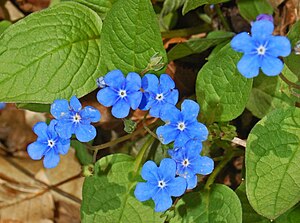Spring umbilical nuts
| Spring umbilical nuts | ||||||||||||
|---|---|---|---|---|---|---|---|---|---|---|---|---|

Spring umbilical nuts ( Omphalodes verna ) |
||||||||||||
| Systematics | ||||||||||||
|
||||||||||||
| Scientific name | ||||||||||||
| Omphalodes verna | ||||||||||||
| Monk |
The Omphalodes Verna ( Omphalodes verna ), also known as large blossom Nabelnüsschen or Gedenkemein , is a herbaceous plant from the family of the Boraginaceae .
description
The spring umbilical is a 5 to 20, rarely up to 30 centimeters high, persistent hemicryptophyte with an ascending to erect, soft-haired stem. It forms runners above ground . The leaves have a long stalk, at least in the lower part of the stem. The leaf blade is broadly ovate and 4 to 15 centimeters long, the leaf base is truncated to weakly heart-shaped. The inflorescence is not or slightly branched and usually consists of 10 to 20 (rarely from 6 to 30) flowers . The corolla has a diameter of 10 to 12 millimeters, rarely from 8 to 15 millimeters. The corolla tube is almost absent, the edge of the crown is sky blue and shows white lines extending from the center between the corolla lobes. In contrast to the similar-looking flowers of forget-me-nots, the round tips of the crown hem in the memorial in the bud position are not twisted in one direction, but rather quincunxially. The maw scales are white. The fruits are disintegrating as with all representatives of the Borage Family in four called Klausen mericarps Klaus fruits . The Klausen are hollowed bowl-show at the apex a membranous Ringsaum and with his back to the pen grown.
The species blooms from April to May.
The number of chromosomes is 2n = 48.
Possibility of confusion
The spring umbilical nut can be confused with the large-leaved Caucasus forget-me-not ( Brunnera macrophylla ), which has a similar habit and is more often cultivated as an ornamental plant .
Distribution and ecology
The natural distribution area is in Europe and ranges from Austria and Italy via Slovenia, Croatia and Albania to Romania. The species is found in moist deciduous trees in a montane location.
The original distribution area within Austria is limited to southern Carinthia, where it grows in the Karawanken , in the Loibl area , in the Rosental and especially in Arnoldstein . In other federal states of Austria it is cultivated as an ornamental plant and is sometimes overgrown, for example in Burgenland, Lower Austria, Upper Austria, Carinthia and Salzburg. In Vienna the species was deliberately abandoned, in Vorarlberg and in the Principality of Liechtenstein the populations have died out again.
In Germany the species is considered a naturalized neophyte. In its original range, it occurs particularly in deciduous forests of the order Fagetalia.
Systematics and history of research
The spring umbilical nut ( Omphalodes verna ) is a species from the genus of the umbilical nut ( Omphalodes ), this is assigned to the subfamily Boraginoideae in the family of the predatory leaf family (Boraginaceae). The species was first scientifically described by Conrad Moench in 1794 in Methodus Plantas Horti Botanici et Agri Marburgensis . The generic name Omphalodes comes from the Greek, means "navel-shaped" and thus refers to the weakly cup-shaped hollowed out partial fruits. The specific epithet verna comes from Latin and refers to spring and thus to the flowering time of the species in the spring months.
A synonym of the species is Cynoglossum omphaloides L.
use
The species is used in the general perennial assortment and as an ornamental plant.
swell
literature
- Manfred A. Fischer , Karl Oswald, Wolfgang Adler: Excursion flora for Austria, Liechtenstein and South Tyrol. 3rd, improved edition. Province of Upper Austria, Biology Center of the Upper Austrian State Museums, Linz 2008, ISBN 978-3-85474-187-9 , pp. 688, 690, 701.
- Helmut Genaust: Etymological dictionary of botanical plant names. 3rd, completely revised and expanded edition. Nikol, Hamburg 2005, ISBN 3-937872-16-7 , pp. 435, 679 (reprint from 1996).
- Henning Haeupler , Thomas Muer: picture atlas of the fern and flowering plants of Germany (= the fern and flowering plants of Germany. Volume 2). Published by the Federal Agency for Nature Conservation. Ulmer, Stuttgart 2000, ISBN 3-8001-3364-4 , p. 398.
Individual evidence
- ↑ a b Fischer, Oswald, Adler: excursion flora for Austria, Liechtenstein and South Tyrol , p. 690.
- ^ Fischer, Oswald, Adler: Excursion flora for Austria, Liechtenstein and South Tyrol , p. 688.
- ↑ a b c d e Fischer, Oswald, Adler: Excursion flora for Austria, Liechtenstein and South Tyrol , p. 701.
- ↑ a b Erich Oberdorfer : Plant-sociological excursion flora for Germany and neighboring areas . With the collaboration of Angelika Schwabe and Theo Müller. 8th, heavily revised and expanded edition. Eugen Ulmer, Stuttgart (Hohenheim) 2001, ISBN 3-8001-3131-5 , pp. 778 .
- ↑ a b Omphalodes verna in the Germplasm Resources Information Network (GRIN), USDA , ARS , National Genetic Resources Program. National Germplasm Resources Laboratory, Beltsville, Maryland. Retrieved November 18, 2017.
- ↑ Haeupler, Muer: Illustrated Atlas of Fern and Flowering Plants in Germany , p. 398.
- ↑ Exactly: Etymological dictionary of botanical plant names p. 435.
- ↑ Exactly: Etymological dictionary of botanical plant names p. 679.
Web links
- Spring umbilical nuts. In: FloraWeb.de.
- Spring umbilical nuts . In: BiolFlor, the database of biological-ecological characteristics of the flora of Germany.
- Omphalodes verna Moench In: Info Flora , the national data and information center for Swiss flora . Retrieved February 5, 2016.
- Thomas Meyer: Umbilical data sheet with identification key and photos at Flora-de: Flora von Deutschland (old name of the website: Flowers in Swabia )

